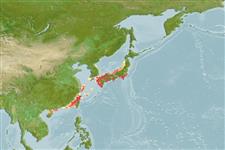Teleostei (teleosts) >
Gadiformes (Cods) >
Moridae (Morid cods)
Etymology: Laemonema: Greek, laimos = throat + Greek, nema = filament (Ref. 45335).
Environment: milieu / climate zone / depth range / distribution range
Ecology
Marine; benthopelagic; depth range 25 - 60 m (Ref. 31160). Subtropical
Northwest Pacific: Japan.
Size / Weight / Age
Maturity: Lm ? range ? - ? cm
Max length : 7.3 cm SL male/unsexed; (Ref. 31160)
Dorsal spines (total): 0; Dorsal soft rays (total): 49 - 60; Anal spines: 0; Anal soft rays: 46 - 53; Vertebrae: 39 - 41. Dwarf species with short, slightly deep body, covered by small deciduous scales; body ending in a narrow caudal peduncle; upper gill rakers 1-2; interorbital width 5.2-7.1% SL ; anal rays 46-53 (Ref. 31160).
Life cycle and mating behavior
Maturity | Reproduction | Spawning | Eggs | Fecundity | Larvae
Meléndez, C., R. and D.F. Markle, 1997. Phylogeny and zoogeography of Laemonema and Guttigadus (Pisces: Gadiformes: Moridae). Bull. Mar. Sci. 61(3):593-670. (Ref. 31160)
IUCN Red List Status (Ref. 130435: Version 2024-1)
Threat to humans
Harmless
Human uses
Tools
Special reports
Download XML
Internet sources
Estimates based on models
Preferred temperature (Ref.
123201): 17.7 - 21.7, mean 19.9 °C (based on 6 cells).
Phylogenetic diversity index (Ref.
82804): PD
50 = 0.5000 [Uniqueness, from 0.5 = low to 2.0 = high].
Bayesian length-weight: a=0.01000 (0.00244 - 0.04107), b=3.04 (2.81 - 3.27), in cm total length, based on all LWR estimates for this body shape (Ref.
93245).
Trophic level (Ref.
69278): 3.3 ±0.5 se; based on size and trophs of closest relatives
Resilience (Ref.
120179): High, minimum population doubling time less than 15 months (Preliminary K or Fecundity.).
Fishing Vulnerability (Ref.
59153): Low vulnerability (10 of 100).
